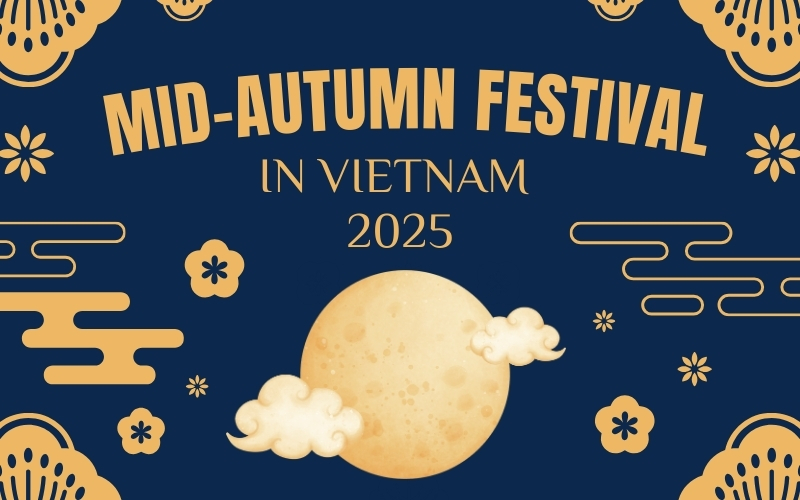
Have you ever wondered why the Mid-Autumn Festival in Vietnam is one of the most magical holidays of the year? Bright lanterns adorn the streets, children play under the full moon, families gather together, and the drums of lion dances echo throughout the night – it’s a festival that combines tradition, joy, and community spirit. In 2025, the festival will be even more special, offering visitors the chance to experience Vietnam at its most colorful and charming. In this guide, you’ll discover the origins and significance of the Mid-Autumn Festival in Vietnam 2025, unique activities, and the best places to celebrate the Mid-Autumn Festival across the country.
Overview of Mid-autumn Festival in Vietnam
The origin of Vietnam’s Mid-autumn Festival
Every year, on the 15th day of the 8th lunar month, the Mid-Autumn Festival in Vietnam becomes more bustling than ever, blending with the cool breeze of autumn. When the full moon rises high, the gentle light of the moon not only illuminates the streets but also lights up the joy in everyone’s heart. Children play, holding colorful lanterns, their laughter blends with the bustling sounds of lion dances echoing throughout the streets, creating a Mid-Autumn night as lively as a festival picture. This is the time when children play, adults relive childhood memories, everyone gathers together to cherish meaningful moments with their families.
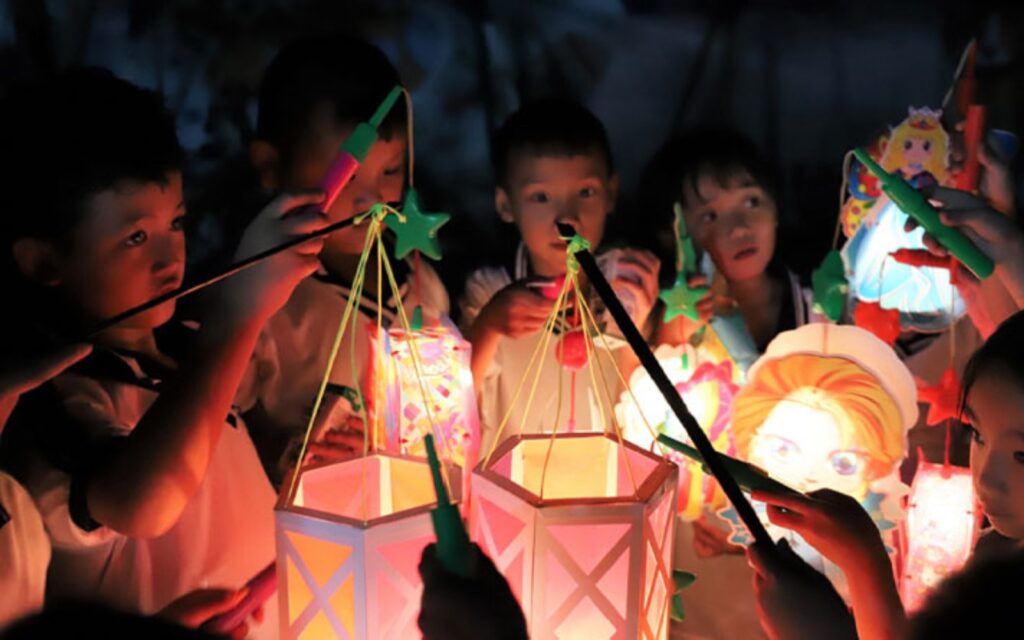
Children celebrating Mid-autumn Festival in the past
But surely many people do not know the origin of this unique festival. During my visit to Hanoi last year, I was lucky to have a very enthusiastic and knowledgeable tour guide. He provided me with a lot of interesting information about this Mid-Autumn Festival, especially for the local people.
The Vietnamese Mid-Autumn Festival was adopted from the Chinese Lantern Festival, which dates back 15-20,000 years. Celebrated during the Tang Dynasty (618-907 AD), the festival was originally held by emperors to honor the moon and gods, and to pray for a bountiful harvest. It was also an occasion for the king to reward officials for their contributions and efforts throughout the year. Over time, the festival evolved into a multi-day celebration where people gather to honor the moon, pray for good luck and fertility, and spend time with family and friends.
Despite its adoption, there are also unique customs and legends associated with the Vietnamese version. The most famous story in Vietnamese culture and told to every child is about a young man named Cuoi, because his wife forgot to water the magical banyan tree, he tried his best to save the tree but failed, and the tree flew up to the moon. Vietnamese people believe that if you look closely on full moon days, you can see a black spot on the moon that looks like a young man sitting behind the ancient banyan tree. On the night of the Mid-Autumn Festival, children will carry lighted lanterns through the streets to guide Cuoi back to the human world.
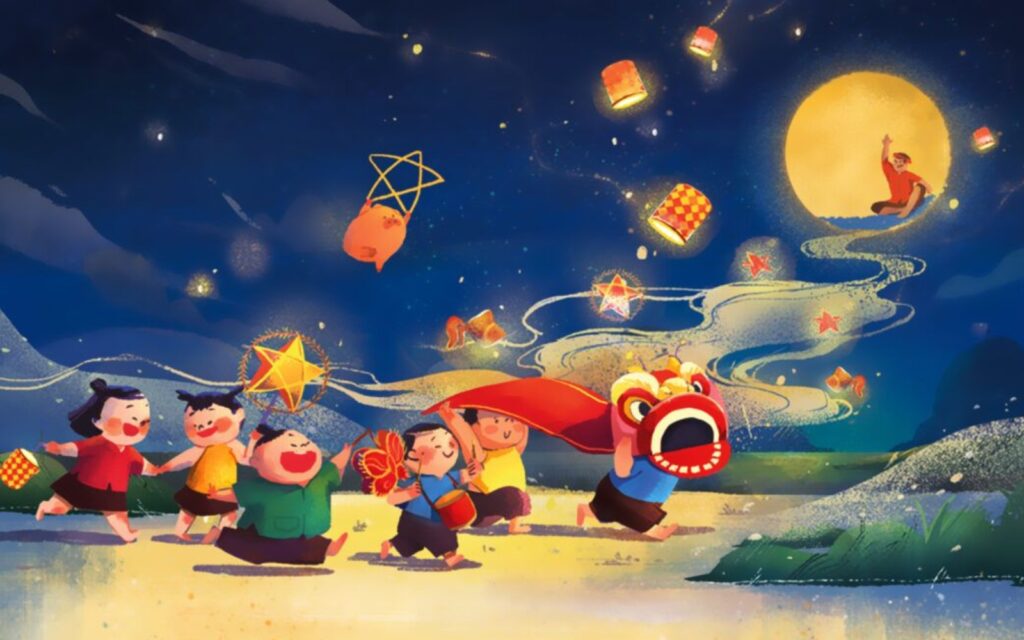
Legend of Chu Cuoi on the Moon
Another legend that is also loved by many children is about Cuoi and Hang Nga. The story is about a beautiful fairy named Hang Nga, who came down to earth to find the most delicious and unique cake to participate in a contest organized by the Jade Emperor. Then she met Cuoi and was helped by him, then won the contest and the cake was named “moon cake”.
Not long after, both of them returned to the moon palace. Because they missed their families, they asked the Jade Emperor for permission to come down to earth once a year. From then on, every year, on the 15th day of the 8th lunar month, Hang Nga and Chu Cuoi were allowed to come down to earth to reunite with their families. The Jade Emperor named this day “Mid-Autumn Festival”, a day of family reunion and children’s joy, marking the beginning of this tradition.
Its significances in Vietnamese culture
The Mid-Autumn Festival plays an essential role in the spiritual life of Vietnamese people. Not only is it a precious tradition preserved through many generations, the Mid-Autumn Festival is also an occasion to strengthen family ties, expressing the following meanings:
- Reunion Festival: Today, the Mid-Autumn Festival in Vietnam is an occasion for families to gather, share happy moments and create memorable memories. This is not only an occasion for children to play with star lanterns but also an occasion for grandparents and parents to gather together, enjoy a cozy meal and sip moon cakes with a cup of hot tea. The round shape of the moon cake, along with the image of the full moon on the Mid-Autumn night, symbolizes unity, completeness, expressing love and connection between generations in the family.
- A special festival for children: In Vietnam, the Mid-Autumn Festival is also a holiday dedicated to children, to make up for the lack of time with their parents. The festival is held after the summer harvest, because parents do not have time to take good care of their children during the harvest season. After finishing their main work, they want to make up for it with a special day as a meaningful gift for their children. Therefore, they take advantage of this day to make children happy by buying lanterns, colorful masks, organizing traditional festivals and lantern parades under the bright full moon. Therefore, any Vietnamese child always looks forward to this holiday every time the 8th lunar month comes.
- Thanksgiving and prayers: Vietnam has long been an agricultural country, where the majority of people live in rural areas and depend on farming. Harvesting, especially rice and other crops, needs to be completed before the 15th day of the 8th lunar month. Therefore, the harvest celebration is also an important part of the Vietnamese Mid-Autumn Festival. After a bountiful harvest, people want to thank their ancestors for giving them a bountiful harvest, with offerings such as fruits, moon cakes and green rice flakes. In addition, this is also an occasion to pray for good things for everyone in the family such as health, success, longevity and a good future.
When is the Mid-autumn Festival in Vietnam 2025?
In 2025, the Mid-Autumn Festival (Tet Trung Thu) will take place on Monday, October 6, which is the 15th day of the 8th lunar month. Unlike many other Western holidays that fall on fixed dates, the Mid-Autumn Festival in Vietnam is based on the lunar calendar, which is why the date changes every year. If you are planning a trip to Vietnam around this time, mark it on your calendar – it is one of the most colorful and family-oriented festivals of the year.
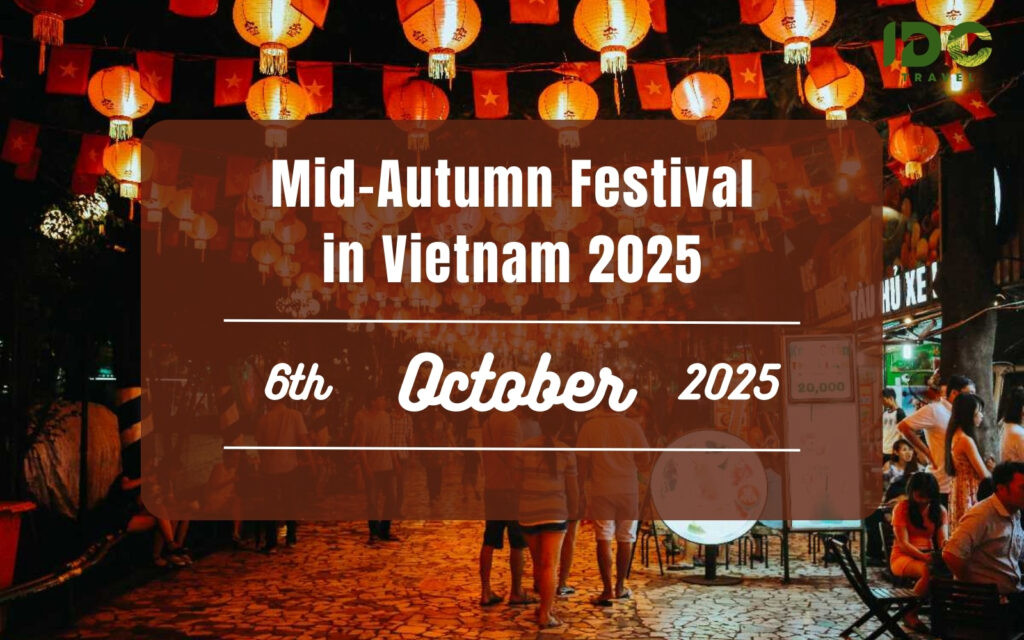
Schedule of Mid-autumn Festival Vietnam 2025
What I love about the Mid-Autumn Festival is that it is not limited to just one evening. Even a month before, you will feel the bustle and atmosphere creeping into every corner. The streets are decorated with lanterns and flags, filled with stalls selling star-shaped lanterns, toy drums and moon cakes arranged in shiny boxes. The laughter of children mingles with the rhythmic sounds of drums used in lion dance rehearsals. On the night of the festival itself, the festive atmosphere reaches its peak. Families with children and young people parade with glowing lanterns under the moonlight, and lion dance troupes perform in communal houses and on crowded streets.
As a tourist, being immersed in this festive atmosphere feels almost magical – you are not only witnessing a festival, but also being immersed in community life. If you want to have the best experience, I recommend coming to Vietnam a few days before October 6. That way, you will have time to explore the festival markets, sample different mooncakes and soak up the pre-festival excitement. Trust me, the anticipation is half the fun.
> > > If you’d love to experience the magic of the Mid-autumn festival firsthand, our specially designed Vietnam tours during the festival will take you to the country’s most festive cities and hidden gems, giving you the perfect mix of culture, tradition, and celebration.
Signature activities during Mid-autumn Festival in Vietnam
Make eye-catching lanterns
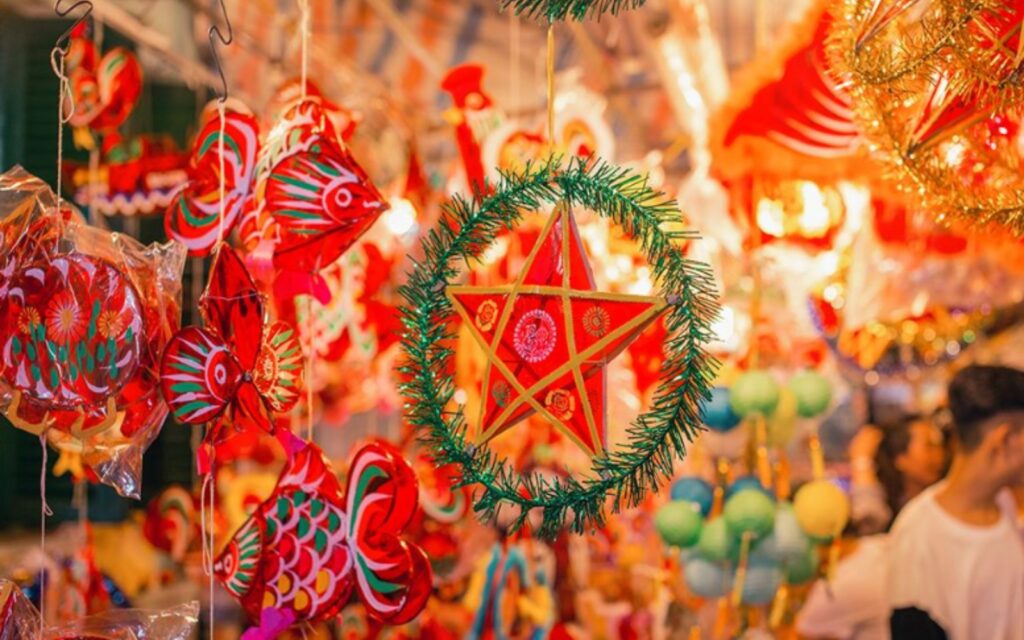
Traditional star-shaped lanterns of Vietnam
If there is one image that immediately comes to mind when I think of the Vietnamese Mid-Autumn Festival, it is the image of children proudly carrying colorful lanterns under the full moon. Although the main event takes place on the 15th night of the lunar calendar, the festive atmosphere continues for weeks before. During the preparation period, lanterns are a prominent feature. They are not only decorative but also a symbol of light, hope and family warmth. Although you can buy colorful lanterns at any stall, it is definitely more wonderful to make your own lantern. This tradition brings people together and allows for creative expression.
Traditionally, lanterns are shaped like stars or carps using bamboo sticks and colored paper. Inside the lantern is a lit candle. In modern lanterns, LEDs replace candles to make them brighter and safer. You can join lantern making workshops where you will learn how to make traditional Vietnamese lanterns. If you want to be more creative with your lantern design, try using everyday items like plastic bottles, milk cartons or recycled paper to create something truly unique. Some popular DIY ideas include fish lanterns, star lanterns, or even miniature houses.
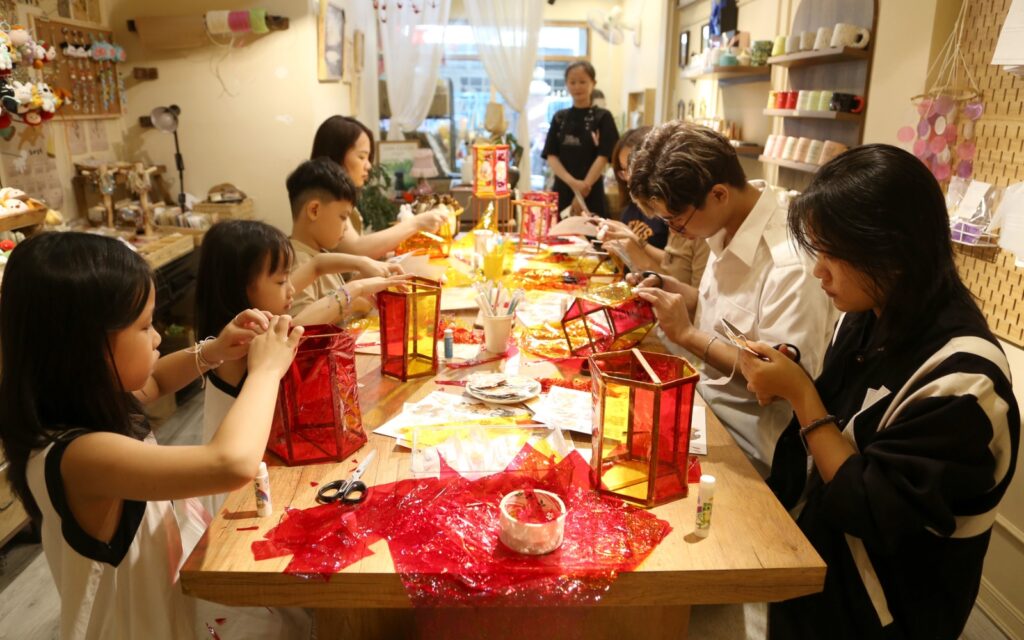
Children crafting lanterns for Mid-autumn festival in Vietnam
On my most recent trip during the festival, I had the opportunity to join a lantern making class in Hoi An Ancient Town. Sitting at a small wooden table with the locals, bending bamboo sticks into star-shaped frames, and wrapping them in brightly colored paper, was both fun and surprisingly relaxing. And when you finally see hundreds of lanterns glowing on the streets, you will understand why this tradition is at the heart of the festival. The soft lighting creates a magical, almost fairytale atmosphere, transforming every corner of Vietnam into a joyous festival. If you are travelling with family or young children, this is definitely one of the best hands-on activities to connect them with the local culture.
Worship the God of Earth and commemorate the ancestors
One of the most meaningful parts of the Mid-Autumn Festival in Vietnam takes place quietly, apart from the lantern parades and lion dances. Families gather at home to set up a special table, usually in the courtyard or outdoors under the bright moonlight, to worship Ong Dia and remember their ancestors. These offerings are meant to express respect and gratitude. Once the offerings have been made, and the spirits are believed to have received their share, the family gathers around the dining table to enjoy a meal, chat, and watch the full moon, a symbol of unity and harmony.
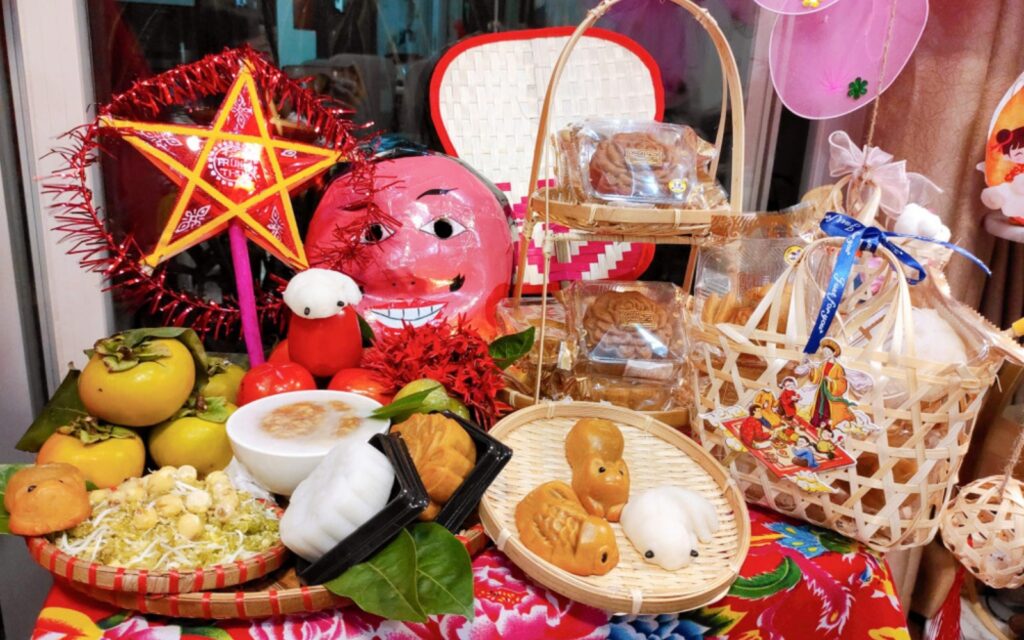
Mid-autumn festival family altar in Vietnam
Growing up in Vietnam, I remember this ritual as both solemn and warm – a gentle reminder that the festival is not only about joy but also about gratitude. The altar is simple but beautiful with fresh fruits and flowers such as bananas, grapefruits, and of course, moon cakes. Some families even add paper lanterns and traditional toys for children, symbolizing light and joy. This activity is a quiet but meaningful aspect of the festival, completely separate from the bustling parades outside. It shows how Vietnamese culture blends family, spirituality and community into one moment.
Gift and enjoy mooncakes, the iconic Vietnamese Mid Autumn Festival food
If there is one thing you absolutely cannot miss during the Mid-Autumn Festival in Vietnam, it is mooncakes, a traditional cake that is only available during this time. These round, sweet cakes are not only a snack but also a symbol of reunion, harmony and luck.
For locals, giving mooncakes to family, friends and even business partners is a way to show respect and strengthen relationships. Of these, banh deo and banh nuong are the two most popular types of cakes, with many sweet and savory fillings such as fruit jam, nuts, lard, chicken floss, salted eggs, chopped green beans, lotus seeds… You can buy them everywhere, from street stalls, shopping malls, supermarkets or even local markets and grocery stores.
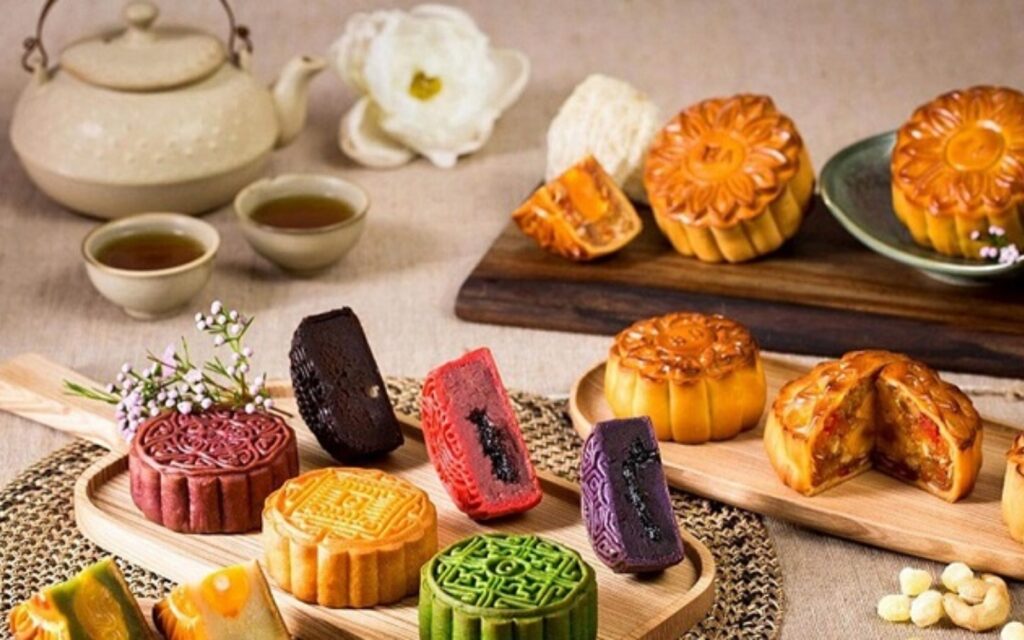
Creative mooncake flavors in Vietnam
The first time I tasted traditional banh nuong, I was surprised by its rich and delicious flavor. The golden brown crust gives way to a signature filling of lotus seeds, mung beans, and salted egg yolks – a perfect balance of sweet and savory. If you’ve never tried it, the salted egg yolks may sound strange, but they make for an unforgettable, rich flavor.
For something a little lighter, try banh deo. With a soft, chewy crust and fragrant fillings like green tea, taro, or even durian, the cakes are refreshing compared to baked cakes. In recent years, bakeries in Hanoi, Ho Chi Minh City, and Hoi An have gotten more creative, introducing mooncakes stuffed with chocolate, matcha, or even tropical fruits, giving this traditional snack a modern twist.
What makes mooncakes special is the way they’re served. Families often gather after dinner, place the cakes on the ancestral altar, and enjoy them together under the moonlight while sipping hot tea. It’s the little moments that help you feel the true spirit of the Mid-Autumn Festival in Vietnam. I once joined a local family in Hanoi, and it was one of those simple, warm moments that made me feel like I was part of something bigger.
Carry lanterns, walk under the moonlight, and sing Mid Autumn Festival songs
During the Mid-Autumn Festival, one of the most exciting activities is the colorful lantern parades and performances. As the full moon rises, the streets come alive as people, especially children, carry large, elaborate lanterns shaped like animals, flowers and folk scenes on the streets. This is the time when children are at their most joyful, holding lit lanterns, forming circles and singing traditional songs. The singing blends with the bustling drum beats of the lion dance, the sparkling lanterns create a festival full of joy.
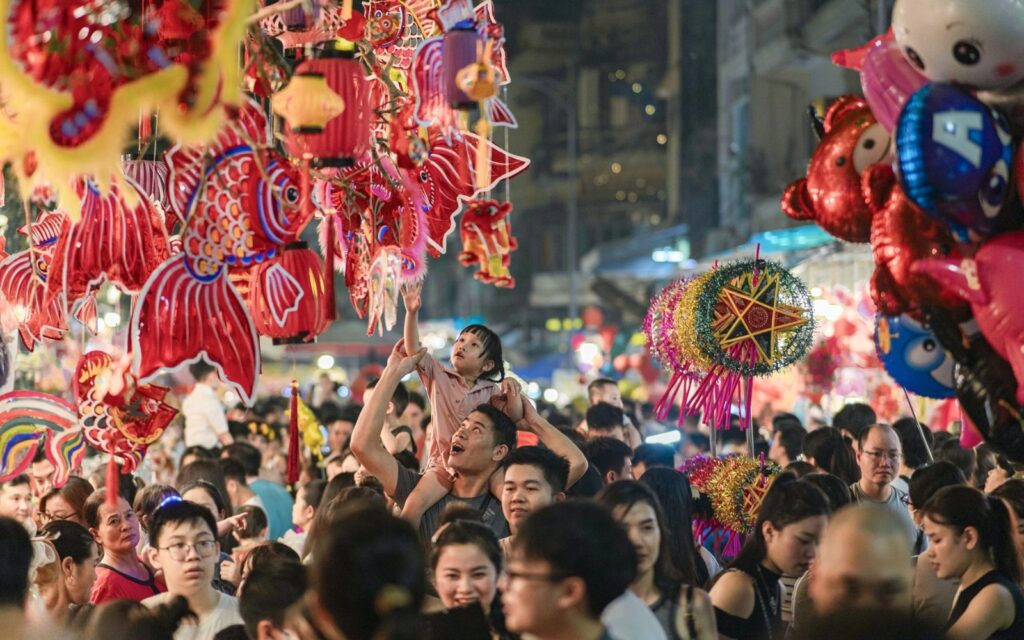
Lantern parade in Vietnam’s Mid-autumn Festival
Major cities such as Hanoi, Ho Chi Minh City and Hoi An are great places to witness these vibrant lantern parades. Be sure to arrive early to get a good spot to admire. I still remember the first time I joined a parade in Hanoi, mingling with the crowd and singing traditional festival songs together. It felt both exciting and warm, like stepping into a living tradition that has been passed down through generations. Don’t worry if you don’t have your own lanterns, you can buy them at markets and street stalls in the days leading up to the festival. Grab one, join the crowd and let the music guide you.
> > > And while lanterns and songs capture the festive spirit, the Mid-autumn Festival is also a time when children and families come together to enjoy traditional games. If you’d love to discover more about these cultural treasures, don’t miss our guide to the 5 Best Vietnam Traditional Folk Games that still bring joy to every festival and village gathering.
Enjoy lion dancing in Mid Autumn Festival in Vietnam
Lion dance is an indispensable part of the festival, bringing joy and excitement to everyone, especially children. It is one of the most exciting moments during the Mid-Autumn Festival in Vietnam. When the drums start to beat along the streets at night, people become even more excited. Children rush forward as a mythical lion, with a giant head and a curvaceous body, is passed by a troupe of acrobats.
With the music and the drums beating, the lion seems to dance and bounce, performing funny tricks that delight the crowd. Children love to touch the lion and are often afraid of “Ong Dia” – the god of the earth, but they still run to watch the performance excitedly. However, when they come face to face with him, they are frightened and cry, thinking that he is a monster.
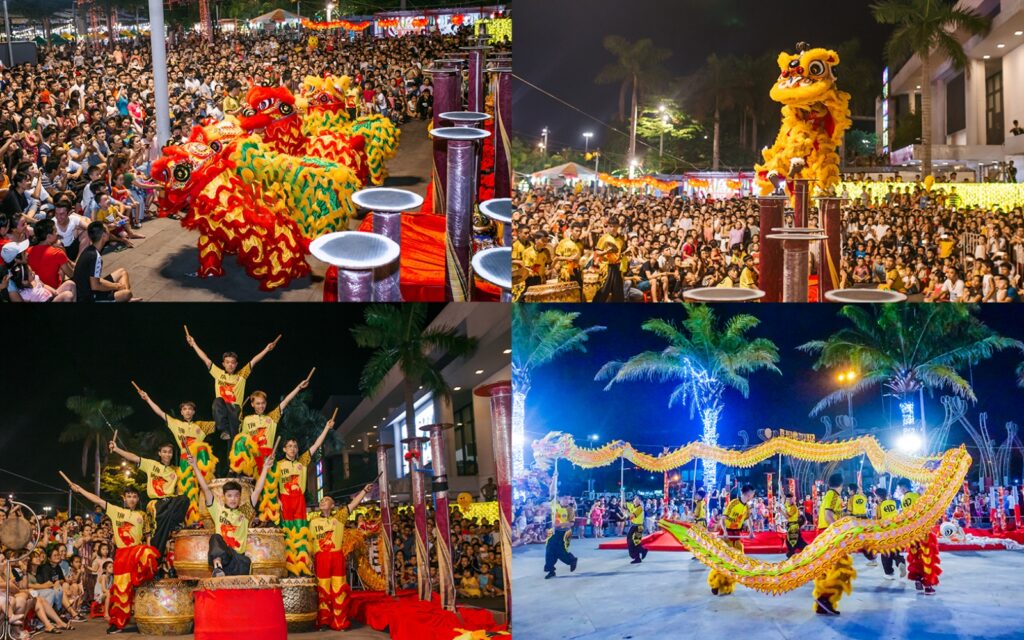
Lion dance performances during Mid-autumn Festival in Vietnam
These innocent moments add laughter and warmth, making the atmosphere even more vibrant and joyful. But what makes them more memorable is the interaction. People don’t just stand and watch, they cheer, clap and follow the lion dance troupe from one performance to the next. I still remember standing on a busy street in Hanoi’s Old Quarter as a troupe of brightly-dressed lion dancers danced and twirled in front of us. The lions were very personable: playful, curious, sometimes mischievous, especially when they leaned in close to the children in the crowd, making them cheer with delight. The acrobatics were impressive, with the performers jumping on each other’s shoulders, spinning and weaving through the streets with incredible coordination.
In addition to being entertaining, the lion dance has deep symbolic meaning in Vietnamese culture. It is believed to ward off evil spirits and bring good luck, prosperity and happiness to families and communities. During the Mid-Autumn Festival, you will often see lion dance troupes visiting shops and homes, performing for blessings and exchanging small red envelopes.
Best places to enjoy Mid-autumn Festival 2025 in Vietnam
Hanoi
As the capital of Vietnam, Hanoi is an ideal destination for you to learn about local culture as well as the values of the Mid-Autumn Festival in Vietnam. During this time, you will feel the bustling atmosphere of thousands of colorful lanterns on the streets, especially in the Old Quarter.
Immerse yourself in Hang Ma Street, the heart of the festival atmosphere filled with lanterns, toys and colorful decorations. On the full moon day, you should go to the streets around Hoan Kiem Lake to enjoy the vibrant atmosphere, watch lion and dragon dances and live performances. Do not hesitate to stroll on the streets, have fun and join the lantern festival with children under the bright full moon. The vibrant atmosphere, filled with the joy of Hanoians of all ages, will certainly leave a lasting impression.
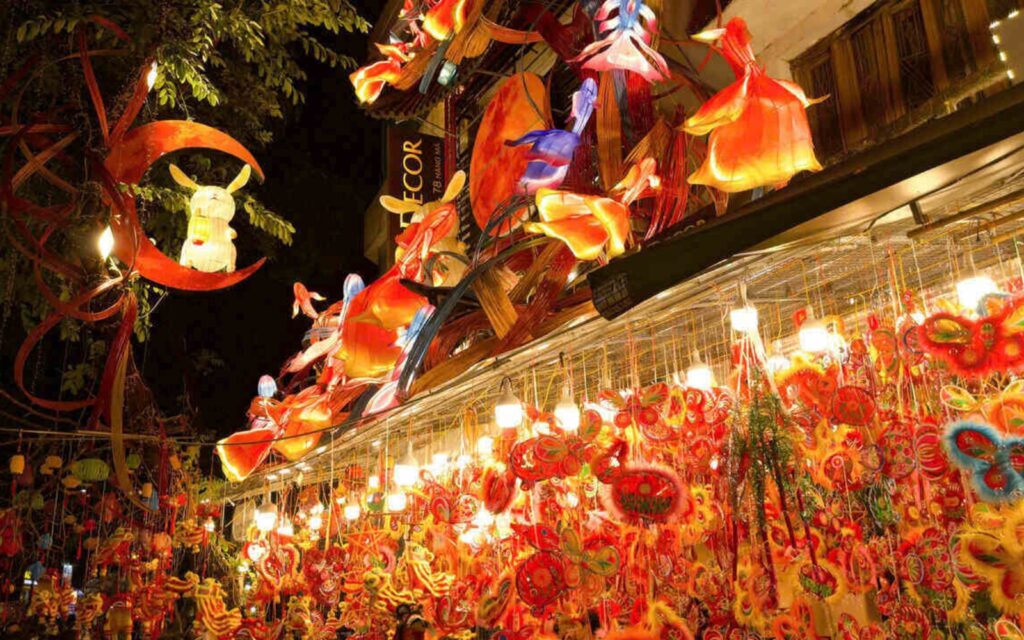
Colorful lanterns and festive decorations filling Hang Ma Street during the festival
I still remember the first time I walked down Hang Ma Street in early October, a narrow, colorful street with thousands of lanterns, paper masks and toys stacked high in every shop. The cafes and tea houses along the way were great places to stop if you wanted to sit back, enjoy a cup of lotus tea and soak up the festivities outside. What impressed me most was that even as a tourist, I still felt warmly welcomed. Locals were happy to explain the significance of certain rituals, or even invite me to try a piece of mooncake.
> > > If Hanoi’s lantern streets and moonlit celebrations have captured your imagination, you’ll love our Idyllic Journey to Northern Vietnam in 6 Days, a tailored tour that combines Hanoi’s festive charm with stunning landscapes, cultural encounters, and unforgettable local experiences.
Hoi An
If there is one place in Vietnam that feels like it was born for the Mid-Autumn Festival, it is Hoi An. The ancient town, already famous for its lanterns, becomes even more charming at this time of year. Lanterns of all shapes and colors are hung everywhere, creating a sparkling light show, illuminating both the streets and the river. During the day, you can join a traditional cooking class to learn how to make mooncakes or join a traditional lantern-making class here.
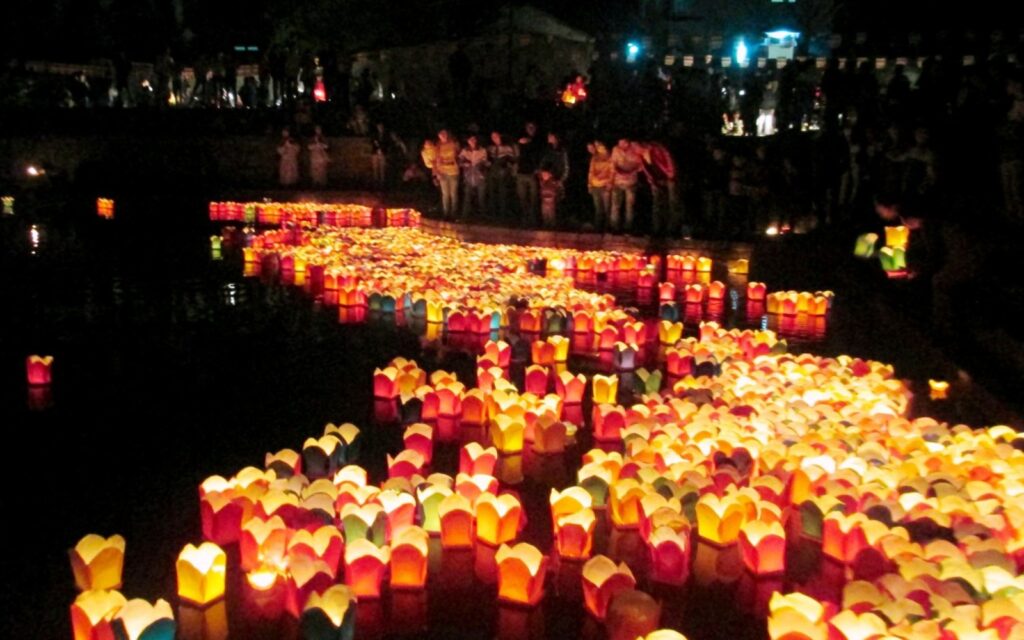
Lantern reflections on Thu Bon River, Hoi An
When the ancient town lights up, Hoi An is a dreamy place for anyone looking for a romantic atmosphere at night. Locals and tourists will line up along the riverbanks, light lanterns and release them into the water to pray for good luck. This makes the river sparkle and poetic, giving visitors a spectacular and unique experience. It is said that releasing lanterns on the water will bring luck and happiness. In addition, local artists also perform cultural performances that contribute to the festival atmosphere, the most famous of which is Bài Chòi along with other folk games such as blindfolded goat catching, disc throwing, mandarin duck catching, etc.
Tuyen Quang
If you want to experience the Mid-Autumn Festival on a whole new level, Tuyen Quang should be on your list. Nestled in the northern highlands, Tuyen Quang is a little-known but culturally vibrant city that celebrates the Mid-Autumn Festival in a big way, becoming increasingly popular with tourists in recent years. Unlike the small paper lanterns you see in other parts of Vietnam, the lanterns here are giant, intricate creations, sometimes taller than a person, shaped like dragons, fairy tale characters, or even modern cartoon icons.
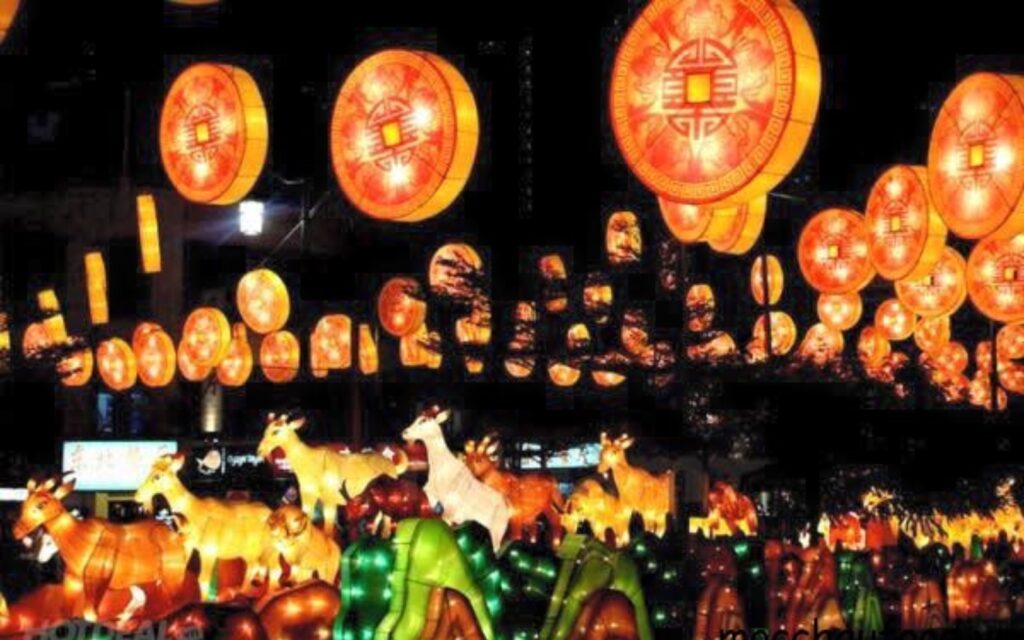
Tuyen Quang Mid-autumn Festival lantern parade
When night falls, the parade comes alive. Whole families join in, proudly carrying their handmade lanterns, while others ride on colorful floats lit from within. The scale of the event is staggering, often referred to as the largest lantern festival in Vietnam, surrounded by thousands of dazzling lights. Locals and tourists from all over flock to line the streets, cheering and waving, while children run around showing off their smaller lanterns. For a visitor, it is an unforgettable opportunity to immerse yourself in a vibrant and authentic local atmosphere.
Ho Chi Minh City
At this time of year, many streets, including Luong Nhu Hoc, Nguyen Trai, Tran Hung Dao and Nguyen An, are decorated with beautiful lanterns and carp-shaped decorations. Visitors can easily stroll down streets such as Luong Nhu Hoc, Nguyen Trai and Tran Hung Dao, admiring the beautiful lanterns. You can also find local street vendors and participate in folk games on these streets.
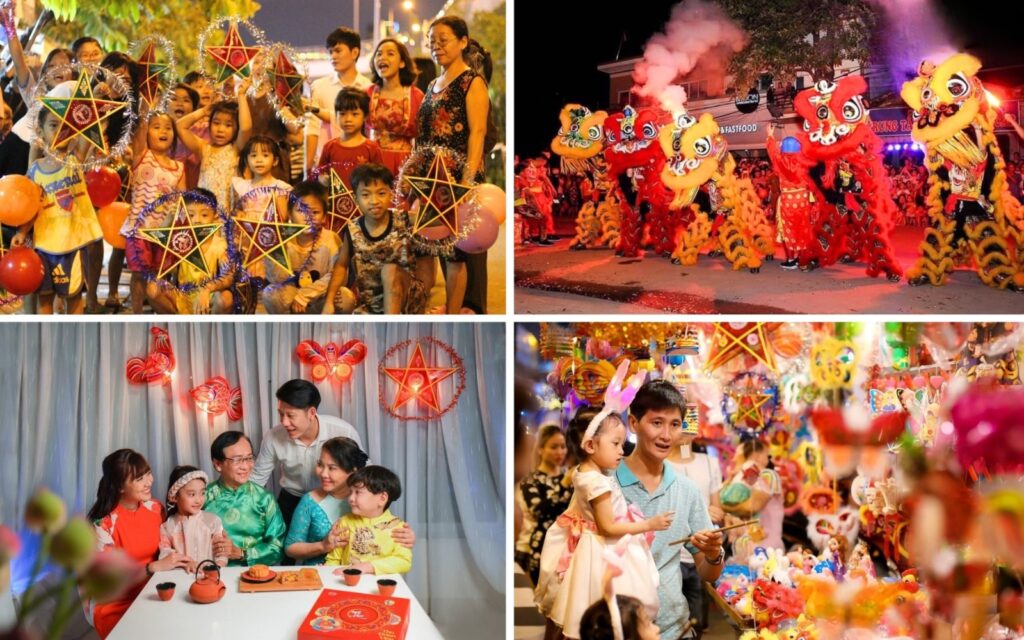
The festival atmosphere in Ho Chi Minh City
And especially, for an authentic Mid-Autumn Festival experience in Ho Chi Minh City, head to District 5, also known as Cho Lon, Saigon’s vibrant Chinatown. Here, the festival atmosphere reaches its peak, with the streets filled with shops and stalls selling colorful lanterns, traditional toys and masks, and lion dance performances, adding to the festive atmosphere. I still vividly remember walking down Luong Nhu Hoc Street in District 5, lantern shops spilling out onto the sidewalks, children holding star-shaped lanterns, and the smell of mooncakes wafting through the air. The whole street seemed to be bustling and bustling, and you couldn’t help but be swept away by the flow of people.
And of course, food was everywhere. Bakeries in Chinatown served up delicious mooncakes, often with creative twists like durian, green tea, or mixed nuts with salted egg yolk. Street vendors sold sticky rice, grilled meats, and pastries to add to the festive atmosphere. Sitting down to enjoy a steaming mooncake and a cup of hot tea while watching the lanterns twinkle above was one of my favorite moments.
> > > And if you’d love to extend your journey beyond the festival itself, our Family Vacation to Highlight Attractions of Vietnam in 15 Days is the perfect way to combine cultural celebrations like Mid-autumn festival with Vietnam’s most iconic destinations, from Hanoi to Hoi An, and the Mekong Delta.
Some useful tips for the best experiences
Experiencing the Mid-Autumn Festival in Vietnam for the first time can be both magical and overwhelming with its lantern parades and crowds. For locals, these traditions are a given, but for visitors, picking up a few insider tips can turn a fun evening into an unforgettable cultural experience. That’s why I’ve put together some practical tips based on what I’ve seen and learned to help you make the most of your Mid-Autumn Festival in Vietnam.
- Prepare for the crowds: The Mid-Autumn Festival is one of the most vibrant and bustling festivals in Vietnam. If this is your first time attending the festival, be prepared for loud crowds, whether in a big city or a small town. It may be a little overwhelming at first, but immerse yourself in the festival atmosphere. Join the locals in carrying lanterns, watching lion dances, and singing along.
- Get there early for the best experience: If you’re not staying near the festival, arrive early, around 6am to 6:30am. Not only will this help you avoid traffic, but it will also help you experience the festival atmosphere from the start.
- Enjoy mooncakes: This is definitely a must-try during the festival. Skip the fancy hotel mooncake boxes. They’re beautiful, but what I remember most are the small bakeries where locals line up, chatting about which fillings are the best this year. That’s where you’ll find authentic flavors and real connections. Grab one, enjoy it with a cup of tea, and you’ll understand why mooncakes are more about family and friendship than dessert.
- Bring spare change: Street food is everywhere during the festival, from skewers to mooncakes and fresh fruit. But most street vendors only accept cash, especially for foreign tourists. And they don’t have much cash to pay if you give them big bills, so change your money first to make it easier to pay.
- Respect the worship culture: In between the parades and music, you will see families quietly placing moon cakes, fruits and incense on small altars. These are sacred objects, not decorations. You can admire and take pictures of them, but never touch the offerings unless the host proactively gives them to you. Locals are very willing to share the food they have offered for visitors to enjoy.
- Choose your favorite festival destination: Each place has a different feel and experience. Hanoi’s Old Quarter is bustling and quaint, Hoi An is romantic with its colorful lanterns, Tuyen Quang is famous for its grand parades and local flavor, while Ho Chi Minh City’s Chinatown is wild, noisy and full of food. Choose the one that suits your style – big city dynamism or small town rusticity.
This article has guided you through everything you need to know about the Mid-Autumn Festival in Vietnam in 2025, from its origins and cultural significance to the best places to experience lantern parades, mooncakes and lion dances. If you are ready to experience the magic of the Mid-Autumn Festival first-hand, we would be delighted to help you plan a trip filled with authentic moments and unforgettable memories. Contact us today and let’s start designing your perfect Mid-Autumn Festival itinerary in Vietnam.
Read more:
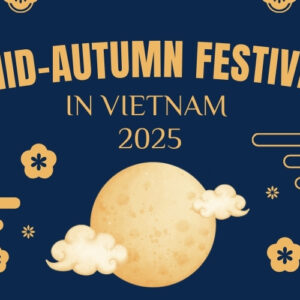
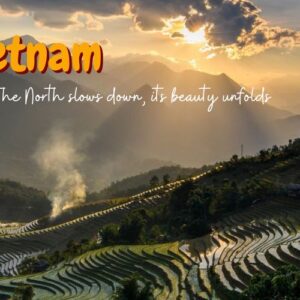


I’m planning to be in Hoi An around October, will the Mid-Autumn activities overlap with the monthly lantern festival there, or are they separate events?
They are separate events,in 2025, the lantern-festival night is October 5, and the Mid-Autumn Festival is October 6. That means if you’re in Hoi An around those dates, you’ll be able to enjoy both almost back-to-back: the magical lantern lighting on the night of October 5, and the full Mid-Autumn celebrations on October 6.
Can I buy mooncakes as a souvenirs for my friends and relatives?
Hi Randy,
During the mid-autumn festival in Vietnam, mooncakes are a kind of wonderful gift, not only to families and friends but also business partners. They are not only delicious but also packed in luxury box. You can easily buy mooncake wherever you go in Vietnam about one month before this event.
Best regards,
Alice Pham.